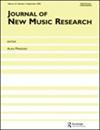节奏对桑巴舞凹槽中相对音符持续时间的影响
IF 0.9
4区 计算机科学
Q4 COMPUTER SCIENCE, INTERDISCIPLINARY APPLICATIONS
引用次数: 4
摘要
先前的研究已经揭示了桑巴十六音符的持续时间模式不均衡。在本研究中,我们研究了节奏对桑巴舞凹槽中这种十六音符模式的影响。结果显示,所有tempi的持续时间都不均匀。有趣的是,随着节奏的增加,最短的音符变得相对较短,最长的音符相对较长。我们认为,节奏之间相对持续时间的差异反映了在所有节奏中保持桑巴十六分音符“模板”的必要性:产生桑巴“感觉”需要根据节奏调整相对持续时间。本文章由计算机程序翻译,如有差异,请以英文原文为准。
Effect of tempo on relative note durations in a performed samba groove
Previous studies have revealed uneven duration patterns at the sixteenth note level of samba. In the present study, we investigated the influence of tempo on such sixteenth-note patterns in a performed samba groove.The results revealed an uneven duration pattern in all tempi. Interestingly, the shortest note becomes relatively shorter and the longest relatively longer as the tempo increases. We suggest that the differences in relative durations between tempi reflect the need to maintain the samba sixteenth note ‘template’ in all tempi: producing the samba ‘feel’ requires that relative durations have to be adjusted to tempo.
求助全文
通过发布文献求助,成功后即可免费获取论文全文。
去求助
来源期刊

Journal of New Music Research
工程技术-计算机:跨学科应用
CiteScore
3.20
自引率
0.00%
发文量
5
审稿时长
>12 weeks
期刊介绍:
The Journal of New Music Research (JNMR) publishes material which increases our understanding of music and musical processes by systematic, scientific and technological means. Research published in the journal is innovative, empirically grounded and often, but not exclusively, uses quantitative methods. Articles are both musically relevant and scientifically rigorous, giving full technical details. No bounds are placed on the music or musical behaviours at issue: popular music, music of diverse cultures and the canon of western classical music are all within the Journal’s scope. Articles deal with theory, analysis, composition, performance, uses of music, instruments and other music technologies. The Journal was founded in 1972 with the original title Interface to reflect its interdisciplinary nature, drawing on musicology (including music theory), computer science, psychology, acoustics, philosophy, and other disciplines.
 求助内容:
求助内容: 应助结果提醒方式:
应助结果提醒方式:


